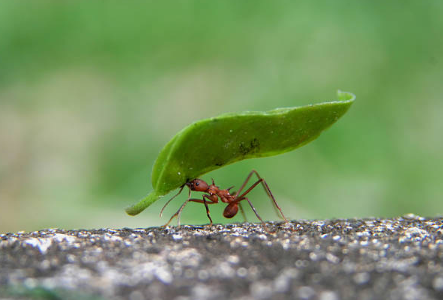How Many Legs Do Ants Have? More Infomation About Ant legs
The thorax of the ant is where the six legs are attached. The abdomen houses the ant’s reproductive organs and vital organs. This is also called the gaster. Ants in the formicine subfamily have an acid pore to emit formic acid when threatened. Continue reading, you will know more about ant legs.
Table of Contents
How Many Legs Do Ants Have?
Ants have specialized body parts that aid in locomotion, just like the majority of living things. These are legs that come in several pairs.
An ant has three sets of pairs of legs, for a total of six legs. There are four legs on each side of these creatures’ bodies: two in the front, two in the middle, and two in the back. The wings and all three sets of legs are located in the mesosoma region of the ant’s body. The muscles in the mesosoma area supply the legs with power and energy. Due to their tiny size, it is difficult to count them with the human eye.
Why Do Ants Have Legs?
Ant legs have six reasons to use in their lives.
Walking and Running
Of course, being able to move around is the most obvious benefit of having legs for ants. Ants spend a lot of time moving around or looking for food inside the nest. The majority of ants are workers, and while the young males and fertile queens of most species have wings to aid in dispersal, the majority of ants lack wings.
Touching
However, some species of ants will also use their front legs to touch and feel, making the antennae of most ants the most crucial part of their body for sensing things and creatures before them.
Building Structures
Many different ant species have the amazing capacity to construct substantial and intricate structures solely from their own bodies. It might be a bridge, a raft on the water, or even a tower. They will use their legs and mandibles to grasp onto one another and the surrounding surfaces. These structures enable ants to successfully navigate challenges that would be too difficult for them to do alone.
Climbing Walls
Ants are able to climb even vertical walls thanks to the structures on their legs.
Grooming
Most ants used their legs to remove food and dirt from their bodies as part of their grooming routine. This helps to stop the spread of disease. Considering that the antennae are the body’s primary sensory organs, cleanliness is crucial. For this reason, some ants have tiny brushes that were adapted from the tibial spur on their legs. To keep their antennae in top condition, they can expertly clean them off using these brushes.
Communication

Ants can communicate in a variety of ways, but they often use pheromones. By rubbing their legs against a unique spike on their backs, some ant species, however, also use their legs to create a type of warning signal. This is referred to as stridulation. Ants can move their legs or touch one another to communicate. They can also use their legs in other ways.
What Are the Different Parts of Ant Legs?
Ants have segmented or joined legs, regardless of how big or small they are. An ant’s leg is composed of several components.
Three joints and two hooked claws make up each individual leg. Claws, which are found at the tips of the feet, aid in climbing any surface by grabbing onto whatever the ant is walking or climbing on. The feet are covered in touch receptors. With the aid of these touch receptors, an ant can comprehend the terrain it is traversing. An ant can communicate with other ants using them as well.
The ant’s leg also has components like the femur and tibia in addition to its claws and touch receptors. These are bones that can also be found in people. These components of an ant’s body are vital to its ability to move from one location to another and to avoid predators.
Why Do Ants Have Hair on the Legs?
An ant has hair all over its body, just like other arthropods do. Setae, the name for these hairs, are connected to the nervous system.
Each of an ant’s legs has setae as well. Additionally, these animals’ touch receptors allow them to feel their environment and facilitate communication. Sound can be heard by the setae. This indicates that an ant has the ability to hear through the hair on its leg.
How Do Ants Climb Walls?
In addition to glass and steel, which appear to us to be too smooth for a grip, ants can climb almost any surface. They use a variety of cunning tools to accomplish this. To begin with, they have pretarsal adhesive pads, which are wet suction cups, on their legs. A liquid fills the cup when the pad is pressed against the surface, and the ant adheres due to capillary action.
They have a number of stiff hairs that serve as a secondary attachment mechanism in addition to their fancy suction cups. Last but not least, they also have a set of forward-facing claws that can grab onto minute surface flaws.
Ants can move across your ceiling like it’s the floor considering everything that’s going on. Even ants can’t get past some artificial surfaces, like Teflon.
Can They Grow Back?
Ants molt as they develop as larvae. Ant larvae don’t have limbs, but some insects that have lost a limb during a molt can regenerate it. The ant stops molting once it has become an adult, so if it loses a limb, it is unable to grow a new one.

In some cases, ants can recover from minor injuries, but they cannot heal from major ones. Ants have a reputation for bringing injured friends back to the nest to heal. The injured ant will frequently tuck its injured leg out of the way if it has one.
How Many Legs Does a Queen Ant Have?
Ants are a type of insect, which means like all insects they have six legs, in three pairs.
Can Ants See Humans?
Army ants have very few means of communication relative to humans. They can only really distinguish between day and night visually. They rely on their senses of smell and touch to sense vibrations; they are unable to even form an image of the environment around them.
Conclusion About Ant Legs
Being an insect, ants have six legs, each with three pairs, just like all other insects. The second major body section, the thorax, which comes after the head and before the abdomen, is where these legs are connected.